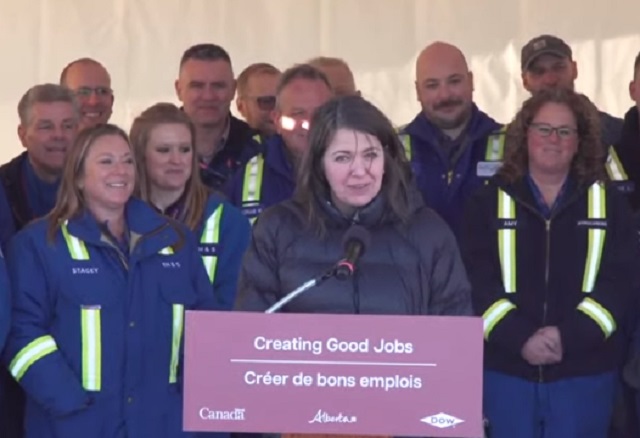Alberta
Multi-billion Dow Chemical investment pegs Alberta as a top spot for low carbon plastics production

The announcement Dow will construct the world’s first net-zero carbon emissions ethylene and derivatives complex, in Fort Saskatchewan, Wednesday November 29, 2023.
From the Canadian Energy Centre
By Will Gibson
Net zero petrochemical complex seen as a signpost for future investment in Alberta’s Industrial Heartland
Dow Chemical’s Nov. 28 announcement confirming it will invest $8.8 billion to build a net zero petrochemical complex near Edmonton was close to a decade in the making for Fort Saskatchewan Mayor Gale Katchur.
“Now that they’ve finally announced the project, I’m one of the happiest mayors around,” says Katchur, who was first elected in October 2010.
“What Dow is building will inspire other industries with innovation and technology like this. Dow has been a cornerstone for our community for the past 60 years. This investment ensures they are going to be around for a lot longer.”
The project, which has support from the municipal, provincial and federal governments, will increase Dow’s production of polyethylene, the most widely used plastic in the world.
Welcomed by the community
By capturing and storing carbon dioxide emissions and generating hydrogen on-site, the complex will be the world’s first ethylene cracker with net zero emissions from operations.
“I remember speaking to Dow executives during their regional visit some years back. They were curious about potential public concerns, given the visibility of their visit and the nature of their business,” Katchur says.
“My response was clear: the primary concern in our community is the pace of progress. People here recognize and appreciate the petrochemical industry. We understand the benefits that it brings.”
Competitive advantages
Katchur’s joy is shared by Mark Plamondon, executive director of Alberta’s Industrial Heartland Association, who sees the Michigan-based multinational’s decision as an endorsement of the region’s competitive advantages.
“Dow is a global company and could put their capital anywhere in the world,” says Plamondon, whose group attracts global investment in heavy industry to the 582-square-kilometre region northeast of Edmonton.
“What this demonstrates is Dow can meet both their economic and environmental goals by investing in this region. That sends a real message.”
Bob Masterson, CEO of the Chemistry Industry Association of Canada, sees Dow’s decision to build the facility as a signal of where the industry will make large investments in the future.
“In the short term, you are looking at the province’s largest construction project requiring more than 7,000 high-skill, high-paying jobs for the next seven to 10 years,” says Masterson, whose Ottawa-based group represents chemistry and plastics producers across Canada.
Alberta a top destination for low carbon chemical production
“What Dow’s decision really says is Alberta is a top destination for the chemistry industry to invest. One of the top chemical producers in the world is making this investment in Canada,” he says.
“When you look at the bigger picture, the only real rival for low-carbon investment of this kind is the U.S. Gulf Coast, where you have the same access to natural gas liquids as a feedstock and supportive public policy environment.”
The Industrial Heartland region is particularly attractive for companies looking to invest in low-carbon products, Masterson says.
“Alberta has an abundant low-carbon feedstock in natural gas liquids to produce hydrogen and the geological space to sequester carbon. These natural assets can encourage investment and support low-carbon chemistry industry,” he says.
“One of the largest petrochemical companies on the planet believes it can build a low-carbon chemistry plant based on these assets. Other companies will see they can generate and extract that value out of those resources in a very sustainable and responsible manner.”
Filling space on the Alberta Carbon Trunk Line
In addition to geological and natural resources, the region already possesses critical infrastructure to woo investment in low-carbon production, such as the Alberta Carbon Trunk Line (ACTL), the world’s largest CO2 pipeline.
Dow has signed an agreement with ACTL owner Wolf Midstream to utilize space on the system.
ACTL is the foundation of a hub that captures CO2 from an oil refinery and fertilizer plant and moves it for permanent storage in a nearby depleted oil field.
The pipeline currently transports 1.6 million tonnes of CO2 per year but is built to transport 14.6 million tonnes of CO2 per year.
“The infrastructure is in place already. The trunk line has plenty of surplus capacity to transport additional emissions,” Plamondon says.
“That just adds to the value proposition for potential facilities that are moving to low-carbon production.”
Alberta
Low oil prices could have big consequences for Alberta’s finances

From the Fraser Institute
By Tegan Hill
Amid the tariff war, the price of West Texas Intermediate oil—a common benchmark—recently dropped below US$60 per barrel. Given every $1 drop in oil prices is an estimated $750 million hit to provincial revenues, if oil prices remain low for long, there could be big implications for Alberta’s budget.
The Smith government already projects a $5.2 billion budget deficit in 2025/26 with continued deficits over the following two years. This year’s deficit is based on oil prices averaging US$68.00 per barrel. While the budget does include a $4 billion “contingency” for unforeseen events, given the economic and fiscal impact of Trump’s tariffs, it could quickly be eaten up.
Budget deficits come with costs for Albertans, who will already pay a projected $600 each in provincial government debt interest in 2025/26. That’s money that could have gone towards health care and education, or even tax relief.
Unfortunately, this is all part of the resource revenue rollercoaster that’s are all too familiar to Albertans.
Resource revenue (including oil and gas royalties) is inherently volatile. In the last 10 years alone, it has been as high as $25.2 billion in 2022/23 and as low as $2.8 billion in 2015/16. The provincial government typically enjoys budget surpluses—and increases government spending—when oil prices and resource revenue is relatively high, but is thrown into deficits when resource revenues inevitably fall.
Fortunately, the Smith government can mitigate this volatility.
The key is limiting the level of resource revenue included in the budget to a set stable amount. Any resource revenue above that stable amount is automatically saved in a rainy-day fund to be withdrawn to maintain that stable amount in the budget during years of relatively low resource revenue. The logic is simple: save during the good times so you can weather the storm during bad times.
Indeed, if the Smith government had created a rainy-day account in 2023, for example, it could have already built up a sizeable fund to help stabilize the budget when resource revenue declines. While the Smith government has deposited some money in the Heritage Fund in recent years, it has not created a dedicated rainy-day account or introduced a similar mechanism to help stabilize provincial finances.
Limiting the amount of resource revenue in the budget, particularly during times of relatively high resource revenue, also tempers demand for higher spending, which is only fiscally sustainable with permanently high resource revenues. In other words, if the government creates a rainy-day account, spending would become more closely align with stable ongoing levels of revenue.
And it’s not too late. To end the boom-bust cycle and finally help stabilize provincial finances, the Smith government should create a rainy-day account.
Alberta
Governments in Alberta should spur homebuilding amid population explosion

From the Fraser Institute
By Tegan Hill and Austin Thompson
In 2024, construction started on 47,827 housing units—the most since 48,336 units in 2007 when population growth was less than half of what it was in 2024.
Alberta has long been viewed as an oasis in Canada’s overheated housing market—a refuge for Canadians priced out of high-cost centres such as Vancouver and Toronto. But the oasis is starting to dry up. House prices and rents in the province have spiked by about one-third since the start of the pandemic. According to a recent Maru poll, more than 70 per cent of Calgarians and Edmontonians doubt they will ever be able to afford a home in their city. Which raises the question: how much longer can this go on?
Alberta’s housing affordability problem reflects a simple reality—not enough homes have been built to accommodate the province’s growing population. The result? More Albertans competing for the same homes and rental units, pushing prices higher.
Population growth has always been volatile in Alberta, but the recent surge, fuelled by record levels of immigration, is unprecedented. Alberta has set new population growth records every year since 2022, culminating in the largest-ever increase of 186,704 new residents in 2024—nearly 70 per cent more than the largest pre-pandemic increase in 2013.
Homebuilding has increased, but not enough to keep pace with the rise in population. In 2024, construction started on 47,827 housing units—the most since 48,336 units in 2007 when population growth was less than half of what it was in 2024.
Moreover, from 1972 to 2019, Alberta added 2.1 new residents (on average) for every housing unit started compared to 3.9 new residents for every housing unit started in 2024. Put differently, today nearly twice as many new residents are potentially competing for each new home compared to historical norms.
While Alberta attracts more Canadians from other provinces than any other province, federal immigration and residency policies drive Alberta’s population growth. So while the provincial government has little control over its population growth, provincial and municipal governments can affect the pace of homebuilding.
For example, recent provincial amendments to the city charters in Calgary and Edmonton have helped standardize building codes, which should minimize cost and complexity for builders who operate across different jurisdictions. Municipal zoning reforms in Calgary, Edmonton and Red Deer have made it easier to build higher-density housing, and Lethbridge and Medicine Hat may soon follow suit. These changes should make it easier and faster to build homes, helping Alberta maintain some of the least restrictive building rules and quickest approval timelines in Canada.
There is, however, room for improvement. Policymakers at both the provincial and municipal level should streamline rules for building, reduce regulatory uncertainty and development costs, and shorten timelines for permit approvals. Calgary, for instance, imposes fees on developers to fund a wide array of public infrastructure—including roads, sewers, libraries, even buses—while Edmonton currently only imposes fees to fund the construction of new firehalls.
It’s difficult to say how long Alberta’s housing affordability woes will endure, but the situation is unlikely to improve unless homebuilding increases, spurred by government policies that facilitate more development.
-

 Automotive2 days ago
Automotive2 days agoHyundai moves SUV production to U.S.
-

 Entertainment2 days ago
Entertainment2 days agoPedro Pascal launches attack on J.K. Rowling over biological sex views
-

 2025 Federal Election1 day ago
2025 Federal Election1 day agoAs PM Poilievre would cancel summer holidays for MP’s so Ottawa can finally get back to work
-

 2025 Federal Election1 day ago
2025 Federal Election1 day agoPoilievre Campaigning To Build A Canadian Economic Fortress
-

 armed forces19 hours ago
armed forces19 hours agoYet another struggling soldier says Veteran Affairs Canada offered him euthanasia
-

 2025 Federal Election1 day ago
2025 Federal Election1 day agoThe Cost of Underselling Canadian Oil and Gas to the USA
-

 Automotive1 day ago
Automotive1 day agoCanadians’ Interest in Buying an EV Falls for Third Year in a Row
-

 conflict18 hours ago
conflict18 hours agoWhy are the globalists so opposed to Trump’s efforts to make peace in Ukraine?





